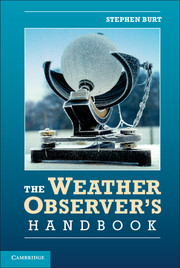Book contents
- Frontmatter
- Contents
- Acknowledgements
- Abbreviations, footnotes and references
- Part One The basics
- Part Two Measuring the weather
- 5 Measuring the temperature of the air
- 6 Measuring precipitation
- 7 Measuring atmospheric pressure
- 8 Measuring humidity
- 9 Measuring wind speed and direction
- 10 Measuring grass and earth temperatures
- 11 Measuring sunshine and solar radiation
- 12 Observing hours and time standards
- 13 Dataloggers and AWS software
- 14 Non-instrumental weather observing
- 15 Calibration
- 16 Metadata – what is it, and why is it important?
- Part Three Making the most of your observations
- Appendix 1 Metrology and meteorology: The basics of instrument theory
- Appendix 2 Useful functions
- Appendix 3 Unit conversions
- Appendix 4 Useful sources
- Index
- References
9 - Measuring wind speed and direction
Published online by Cambridge University Press: 05 July 2012
- Frontmatter
- Contents
- Acknowledgements
- Abbreviations, footnotes and references
- Part One The basics
- Part Two Measuring the weather
- 5 Measuring the temperature of the air
- 6 Measuring precipitation
- 7 Measuring atmospheric pressure
- 8 Measuring humidity
- 9 Measuring wind speed and direction
- 10 Measuring grass and earth temperatures
- 11 Measuring sunshine and solar radiation
- 12 Observing hours and time standards
- 13 Dataloggers and AWS software
- 14 Non-instrumental weather observing
- 15 Calibration
- 16 Metadata – what is it, and why is it important?
- Part Three Making the most of your observations
- Appendix 1 Metrology and meteorology: The basics of instrument theory
- Appendix 2 Useful functions
- Appendix 3 Unit conversions
- Appendix 4 Useful sources
- Index
- References
Summary
The wind is the most variable of all weather elements. The speed of the wind can double, or halve, within a few seconds. Its direction can, and occasionally does, change by 180 degrees within a minute, and can make several turns right around the compass within an hour or two. Wind direction and speed both vary continuously with a time-period measured in seconds, about a mean value which itself changes on a minute-by-minute, hour-by-hour, day-to-day and month-to-month basis (Figure 9.1) in fractal-like fashion. The wind can blow with barely perceptible force, or with sufficient strength to cause complete destruction of forests and buildings. It is also one of the most important measurements in operational meteorology and in aviation forecasting.
Measuring and summarizing such a fickle element poses considerable challenges, not least in requiring rapid-response sensors (coupled with high sampling and logging rates) that are also physically robust. They must respond accurately in the lightest of breezes, yet also be capable of surviving winds in excess of hurricane force.
The exposure of the instruments themselves is also vital for accurate, reliable and comparable results. The recommendations of the World Meteorological Organization [1] are that wind instruments should be sited on level terrain with no significant obstacles within 100 metres, but even WMO accept that ‘in practice, it is often difficult to find a good or even acceptable location’. For this reason, high-quality wind records can be the most difficult to obtain of all of the more common weather elements, especially in a domestic or sheltered suburban environment where a ‘perfect’ exposure is almost impossible to realize. The necessarily elevated nature of the sensors can pose significant safety issues for access, installation and maintenance, while continual exposure to the elements at height (rain and snow, ice and frost, sunshine and solar radiation and possibly lightning, in addition to buffeting by the wind itself) takes its toll on sensor reliability, longevity and electrical connections. In a windy location, even the best sensors may last only a few years before replacement is necessary.
- Type
- Chapter
- Information
- The Weather Observer's Handbook , pp. 192 - 221Publisher: Cambridge University PressPrint publication year: 2012
References
- 3
- Cited by



